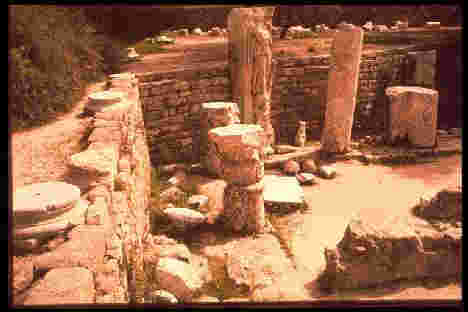|
Other Archaeological Sites / The Neolithic of the Levant (500 Page Book Online) Ancient Ashkelon (Ashqelon) Archaeological site in Palestine on the Mediterranean Sea 15 miles northeast of Gaza. An ancient city settled in the third millennium BC, it was taken over by the Philistines in the 12th century BC and became one of the five city-states called the Philistine Pentapolis. It flourished under many rulers as a major port and trade center between Syria and Egypt. Excavation of the city's important remains began in 1920. The modern city is nearby ... (AHSFC)
Ashkelon Excavations -- The Leon Levy Expedition Ashkelon was the capital of Canaanite Kings and the harbor of the Philistines and the stomping ground of the biblical hero Samson. From the Canaanite era Ashkelon is the oldest and largest seaport yet known in Israel and a thriving Middle Bronze Age (2000-1550 BC) metropolis of more than 150 acres with commanding ramparts including the oldest arched city gate in the world, still standing two stories high. From the Philistine era (1175-604 BC) excavations of the seaport are uncovering remains of the city from the days of Samson and Delilah and the city's destruction by Babylonian King Nebuchadnezzar ...
Ashkelon Excavations At Harvard University (Project Reports) PDF
1
2
3
4
INTRODUCTION: ASHKELON AND ITS INHABITANTS
The pressure of the subterranean fresh water flowing from the east prevents the sea from making the local groundwater brackish, as would otherwise happen along the shore. At the site of Ashkelon, dozens of ancient wells have been discovered which tap this water source at a depth not far below the modern surface. The oldest well excavated at the site of ancient Ashkelon dates to circa 1000 B.C. and no doubt many wells were dug there long before that. In the past, as today, the availability of abundant fresh water made Ashkelon a veritable oasis. In 1921 the British archaeologist W. J. Phythian-Adams remarked on this feature of the site as follows: The sea coast of Palestine may be called one of the curiosities of the world. Its long, pitiless sweep from the Egyptian frontier to Carmel is familiar to all to whom this land is holy and its chief characteristic is plain, so to speak, upon its face. It has no natural harbour. . . . On such a coast we have to ask ourselves why any one point rather than another should be selected as a port and to this we shall probably find a ready answer. Primitive man in his search for fresh water over the parched plains of Philistia found it sometimes where he least expected it, on the seashore. One such oasis amongst the sand-dunes stands on the very brink of the Mediterranean some 12 miles north of Gaza. Its wells to this day can be counted by scores. Here you will find palms and hedgerows, fields green with cultivation and bounteous with grateful shade. This Paradise is Askalon. [Phythian-Adams 1921a:76] From The Neolithic of the Levant by A. M. T. Moore: Page 367: Ashkelon is another site in the dunes which was discovered when the new port was built. Perrot excavated it and found a number of pit dwellings from 2 to 5 m in diameter and as much as 1 m deep (1968). There were also smaller hollows interpreted as storage pits and hearths. The arrowheads were either tanged or leaf-shaped often with very thin points. The sickle blades were segmented and denticulated. There were several flaked and polished trapezoidal and oval axes as well as bifacially retouched tabular flint knives. The remainder of the chipped stone assemblage consisted of burins, borers and scrapers and also a scrap of obsidian. No pottery was found at Ashkelon but there were a number of other finds, among them grinding tools, stone bowls and bone points. There were several ornamental objects such as stone bracelets and shell beads together with some spindle whorls. The affinities of the flint tools are with other phase 1 sites but the absence of tanged and winged arrowheads and also pottery suggests that the site may have been occupied quite early in this phase. Page 394: The inhabitants of Ashkelon ate both fish and shellfish as one would expect on a site so near the sea. They also killed cattle (Bos taurus), gazelle and goats (Perrot 1968). These three animals were probably herded or controlled. La prehistoire Palestinienne by J Perrot in Dictionnaire de la Bible (1968) |

